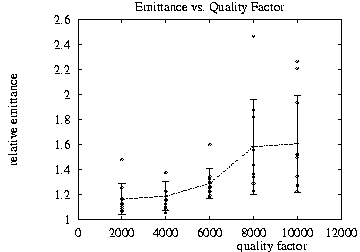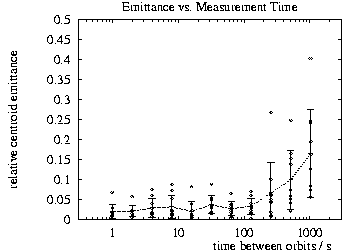M. Drevlak,
MPI f. Plasmaphysik, D-17491 Greifswald
With sufficient damping of long-range Higher Order Modes,
the emittance dilution in the S-band Linear Collider is dominated
by single bunch effects. We present an improved parameter set
with reduced bunch charge which allows to relax the positioning
tolerances in the main linac. The consequences for the other subsytems
of the collider are also briefly discussed.
The S-band approach towards a next generation Linear Collider
of 500 GeV center-of-mass energy represents the most conservative
one of several concepts presently under investigation [1]. The
technology is well known for many years and the experience from
the only existing Linear Collider, the SLC, can be used most directly.
The relatively low frequency (3 GHz) is beneficial for keeping
emittance dilution from wakefields small. In this context, a low
bunch charge Ne is favorable since it reduces the short-range
wakefields. This led us to a modification of the beam parameters,
as will be described in the following.
The dilution of the beam emittance in the linac due to transverse
short-range wakefields scales approximately as
Here, ![]() z
denotes the bunchlength and
z
denotes the bunchlength and ![]() yc the
rms error of transverse structure alignment w.r.t. the beam orbit.
The average focussing strength in the linac is expressed by <
yc the
rms error of transverse structure alignment w.r.t. the beam orbit.
The average focussing strength in the linac is expressed by <![]() >,
we assume a scaling
>,
we assume a scaling ![]() =
=![]() 0(E/E0)1/2
with
0(E/E0)1/2
with ![]() 0=13m at E0=3GeV. Stronger focussing
seems advantageous with regard to transverse wakefield effects,
but would lead to increased emittance dilution from chromatic
aberrations.
0=13m at E0=3GeV. Stronger focussing
seems advantageous with regard to transverse wakefield effects,
but would lead to increased emittance dilution from chromatic
aberrations.
The parameter optimization consists in a reduction of bunch charge by a factor of 0.4 and of bunch length by a factor of 0.6. The pulse current (and thus the average beam power) is kept unchanged by an appropriate reduction of bunch spacing and the interaction parameters are adjusted in order to keep the beamstrahlung constant. A complete overview of the S-Band Linear Collider (SBLC for short) parameters is given in table 1. According to eq. (1), we gain an order of magnitude reduction in transverse short-range wakefield effects. Part of this improvement is used to lower the vertical beam emittance (yielding a higher luminosity), the other part to relax the structure alignment tolerances. With the modified beam parameters, a complete simulation of beam dynamics also including other important effects such as long-range wakefields and chromatic aberrations has been performed.
| NEW | OLD | ||
| total length | 34 | 34 | km |
| tpulse | 2 | 2 | µs |
| nb/pulse | 333 | 125 | |
| 6 | 16 | ns | |
| frep | 50 | 50 | Hz |
| Ne/bunch | 1.1 | 2.8 | 1010 |
| 5/0.25 | 10/.5 | 10-6 m | |
| 11/0.45 | 22/0.8 | mm | |
| 335/15 | 670/29 | nm | |
| 0.3 | 0.5 | mm | |
| cross. angle | 6 | 3 | mrad |
| < | 3 | 3 | % |
| Pb (2 beams) | 14.5 | 14.5 | MW |
| PAC (2 linacs) | 140 | 140 | MW |
|
| 10.3 | 10.3 | % |
| luminosity L | 5 | 3.4 | 1033cm-2s-1 |
The beam dynamics in the S-band linac have been investigated by using the L3 particle tracking code [2]. The following assumptions are made for this study:
For the reduced bunch charge, the longitudinal wakefield [5] is sufficient to provide BNS damping so that an rf-phase of zero deg., i.e. on-crest acceleration, is chosen. The correlated energy spread in the bunch is 0.35% in this case, about a factor of two smaller than in the previous design. Thus the parameter change is also beneficial for reducing chromatic emittance dilution from spurious dispersion. At the injection energy of 3GeV, an additional uncorrelated energy spread of 1% is taken into account. The bunch-to-bunch energy spread can be kept smaller than the single bunch energy spread by suitable beam-loading compensation [6] and is neglected here.
The simulation is performed for different values of the HOM quality
factors in the range Q=2,000...10,000 using 10 different random
seeds for each value of Q. The results for the vertical emittance
growth are shown in fig. 1. The "lossy iris" HOM damping
concept yields Q-values of 2,000...3,000 and we obtain a relative
increase of the emittance of ![]()
![]() y/
y/![]() y =(20
y =(20![]() 10)%.
10)%.

Fig.1: Simulation results for the vertical
beam emittance (normalized by the design emittance) at the end
of the S-band linac as a function of HOM quality factors.
Further computer simulations concerning the issue of long-term beam stability under the influence of ground motion were performed. We assume an uncorrelated diffusive ground motion according to the ATL-rule:
where L is the distance between two points along the linac and T the time. From measurements of orbit motion in HERA [7] we obtain A=10-17 m/s as a conservative upper limit. Starting with an ideal machine without alignment errors, the evolution of emittance dilution with time is determined. We find an emittance growth of 6% after 25 min. This means that after finding a "golden orbit" with the WF-method, an orbit correction which steers the beam back to this "golden orbit" has to be applied every 25min. in order to limit the additional emittance dilution to an average of 3%.
The effect of diffusive ground motion on the WF-correction method has also been studied. Since this method is based on measuring difference orbits after changing quadrupole strengths, which will require a certain amount of time, ground motion has the potential to spoil the measurement. We find that the time required for taking the difference orbits should not exceed 100s to avoid significant emittance dilution with the WF-method (see fig. 2).

Fig. 2: Emittance growth caused by diffusive
ground motion with A=10-17 m/s during the process of
WF-correction as a function of time between orbit measurements.
The results of the beam dynamics study show that the reduced
vertical emittance of the new parameer set can be obtained with
reasonable alignment tolerances, which, in case of structure alignment,
are more than a factor of two relaxed compared to the older version
of the S-band parameters. In the studies presented here, empirical
minimization of emittance dilution by using orbit bumps (common
praxis at the SLC) is not yet included. This provides an additional
safety margin in the S-band design.
The change of the beam parameters has a significant impact on the SBLC subsystems such as the damping ring and the final focus system.
The damping ring has to provide an emittance which is reduced by a factor of two in both planes. Fortunately, the original damping ring design [8] is capable of providing the required beam quality. With regard to single bunch instabilities the reduced bunch charge is an advantage. In case a multi-bunch feedback system is needed (this question is under study), the reduced bunch spacing can cause larger bandwidth requirements.
With the reduced bunchlength, stronger requirements for the bunch compressor result, but a single stage compressor device as described in [9] still seems feasible.
The final focus system must provide beta functions at the interaction point which are reduced by about a factor of two. This turns out to be straightforward without any problems concerning the momentum bandwidth. The vibration tolerances are somewhat tighter than for the older design, though. It is planned to use a fast orbit steering device at the interaction point to minimize luminosity loss from transverse beam separation [10].
The concept of dispersive crab-crossing [11] using the correlated
energy spread in the bunch becomes more efficient, mainly due
to the smaller bunchlength: For a given energy spread and dispersion,
the maximum crossing angle which can be compensated scales like
![]() z-1. We make use of this advantage by increasing
the crossing angle from 3mrad to 6mrad, thus creating more aperture
for the outgoing beam, beamstrahlung and synchrotron radiation
leaving the interaction region. The residual luminosity reduction
due to the crossing angle amounts to about 5% in this case.
z-1. We make use of this advantage by increasing
the crossing angle from 3mrad to 6mrad, thus creating more aperture
for the outgoing beam, beamstrahlung and synchrotron radiation
leaving the interaction region. The residual luminosity reduction
due to the crossing angle amounts to about 5% in this case.
It has been shown that with the new parameter set for SBLC,
a higher luminosity and at the same time relaxed tolerances can
be obtained. The impact of the parameter modification on the overall
design has been studied and found acceptable.
[1] G. A. Loew (ed.), "International Linear Collider Technical
Review Committee Report", SLAC-R-95-471, 1995.
[2] M. Drevlak, "On the Preservation of Single- and Multi-Bunch
Emittance in Linear Accelerators", Thesis, TH Darmstadt D17,
1995.
[3] T. Raubenheimer, "The Generation and Acceleration of
Low Emittance Flat Beams for Future Linear Colliders", Thesis,
SLAC-387, 1991.
[4] M. Dohlus, to be published.
[5] M. Drevlak, "Wake Potential of Short Bunches in the SBLC
Accelerating Structure", DESY-M-95-13, 1995.
[6] N. Holtkamp and A. Jöstingmeier, "Multibunch Energy
Compensation in Travelling Wave Linear Accelerators", DESY-96-043,
1996.
[7] R. Brinkmann and J. Roßbach, "Observation of Closed
Orbit Drift at HERA covering 8 Decades of Frequency", Nucl.
Instr. Meth. A350, p. 8, 1994.
[8] R. Brinkmann, "A study of Low Emittance Damping Ring
Lattices", DESY-M-90-09, 1990.
[9] P. Emma, "Bunch Compressor Beamlines for the TESLA and
S-band Linear Colliders", DESY-TESLA-95-17, 1995.
[10] G.-A. Voss, R. Brinkmann and N. Holtkamp, "A Beam-Based
Interaction Region Feedback for the S-Band Linear Collider",
contribution to this conference.
[11] R. Brinkmann, presented at the LC92 workshop on Linear Colliders, Garmisch 1992, ECFA Proc. 93-154, Vol. II, p. 549.